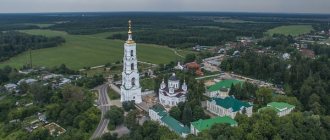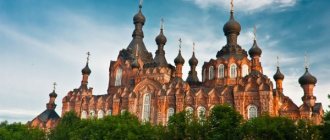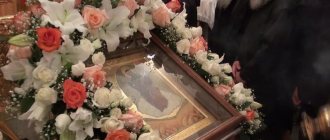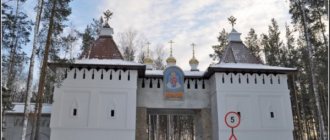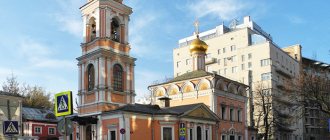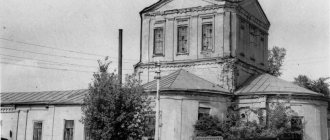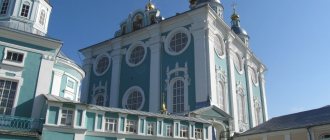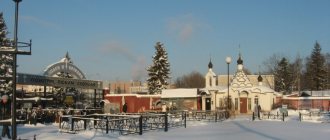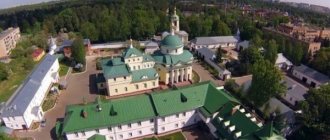There are plenty of monasteries with ancient history in Rus'. The Sredneuralsky Convent, which is twenty kilometers north of Yekaterinburg, is not one of them. His birth occurred in the present century. And many living today are witnesses to this. The monastery is dedicated to the Mother of God icon “Spreader of the Loaves”; the confessor is schema-abbot Father Sergius Romanov.
This place is special. He has a remarkable history, and most importantly, an enduring desire to please the Lord, to live like angels in service. That is why the nuns pray selflessly and fervently. The glorification of Christ and His Most Pure Mother does not stop here for a minute, prayers are heard for every soul and all of Russia. And the love of the Gospel, with which one is greeted at the monastery, will never cease, not judging anyone and thanking for everything. There is so much love here. It is by this that the disciples of God are recognized.
History of the convent
On the site of the women's courtyard of the men's monastery from Ganina Yama, near Sredneuralsk, a monastery was founded not very long ago and was named in honor of the icon of the Mother of God “Spreader of the Loaves.” Four ascetics took up the arrangement of it under the vigilant leadership of Hieromonk Sergius, who at that time was the abbot of the monastery in the name of the Royal Passion-Bearers.
So it turned out that the monastery of the Mother of God grew from a small gatehouse near the green lawn in a fairly short time. In May 2002, workers got down to business. White-stone churches rose to the skies, and the buildings of the Sredneuralsky convent of wood and stone grew. A chapel with a bathhouse was installed above the spring with healing water. And all this was completed by 2011 - a record-breaking time frame. Construction work continues to this day.
The number of nuns together with workers is almost three hundred people. The monastery is separated from Yekaterinburg by some twenty kilometers. The September day of 2004, when the temple was consecrated in honor of the icon of the Mother of God “Spreader of the Bread,” was solemn. The Holy Synod established the monastery by its decision on April 20, 2005.
It is possible that you will be interested in an article about the Assumption Tikhvin Monastery.
“Instead of God - Father Sergius.” Life in a rebel monastery
On February 10, the Arbitration Court of the Sverdlovsk Region recognized the ownership rights of the Ekaterinburg Diocese to the Church “Contestant of the Loaves” of the Sredneuralsky Convent, the rector of which, former schema-abbot Sergius (Romanov), has been under arrest since December 29, 2021. Then the security forces literally took the monastery by storm, but this did not help return the rebellious parish to the fold of the Russian Orthodox Church. As it turned out, his lands and buildings were simply not registered in the diocese.
The monastery community, photo from the VKontakte group
Most of the lands of the Sredneuralsky convent “Spitter of Loaves,” according to Ura.ru, belong to the forest fund. The total area of forests occupied by the monastery is approximately 250,000 square meters, of which only 35 thousand square meters are decorated. m. To clarify this information, a Radio Liberty correspondent sent a request to the Ministry of Natural Resources and Ecology of the Sverdlovsk Region, but no response has yet been received.
In December 2021, the Ekaterinburg diocese appealed to the Arbitration Court of the Sverdlovsk Region to establish ownership of the monastery church, which, according to the diocese, was seized by the disgraced cleric. On February 10, several nuns of the Sredneuralsky convent tried to enter the process as third parties in order to protect their housing rights. They wanted to prove that the building of the temple in honor of the icon of the Mother of God “Spreader of the Loaves” is residential: there are cells on the first two floors, and the temple itself occupies only the third floor. But the court rejected their arguments.
The Arbitration Court of the Sverdlovsk Region began considering the case on February 5, 2021. Father Sergius’s former comrade-in-arms, Abbess Varvara (in the world – Svetlana Krygina), who left the monastery in mid-June 2020, on the eve of the process, registered a religious organization, the name of which completely repeats the name of the rebellious monastery. According to the plan, this was supposed to help in considering the case.
On the eve of the first meeting of the arbitration court, a video message from another nun of the Sredneuralsky convent appeared on YouTube, in which she says that if the court decides in favor of the diocese, then a new assault is possible, and then the nuns will simply have nowhere to go. According to her, 480 people now live in the monastery, including 60 elderly people and 40 children.
The decision on February 10 in favor of the diocese was made “without taking into account the position of the nuns’ lawyers and Father Sergius,” according to the monastery’s public page. “The court’s decision will be appealed to the Seventeenth Arbitration Court of Appeal (Perm). We hope that no pressure will be exerted on the court in another region,” representatives of the monastery said on social networks.
On the eve of the trial, a Radio Liberty correspondent visited the monastery to see with my own eyes how everything worked.
“You, grandma, are a heretic!”
Father Sergius built not only the Sredneuralsky convent, but also other monasteries and monasteries throughout the Sverdlovsk region. Among them are the village of Novoselova and the Kyrtomsky monastery in the vicinity of Alapaevsk. As a rule, objects were built without proper approvals and subsequent registration.
“Father Sergius built many monasteries, for which he is respected,” says Orthodox Yekaterinburg resident Tatyana Znak . “I built the Ganina Yama, then it was moved to a new place, and the donors again follow it, again creating something new. And the Russian Orthodox Church is taking it again. And so, this time he wised up and registered all the buildings as private individuals, and not as the diocese. And the diocese did not give money for construction, it was people who brought it, his spiritual children. They have everything there, herds, chicken, milk, meat.
“It must be said that legal support in the Russian Orthodox Church is at an extremely low level, land acquisition and the construction of churches are not done centrally,” explains religious scholar from Bashkiria Vadim Rosenfeld . – I think that not a single diocese, even one as rich as Yekaterinburg, paid due attention and control to this. Not a single diocese, even a rich one, ever builds anything or invests money. There is a slogan: “Look for a sponsor, guys!” And Sergius was valuable because he knew how to find sponsors, he could build a lot, and accordingly, contributions to the diocese flowed like a river, and that was enough. To whom, what was registered there, and how – no one cared at all.
The people who are there do not have the right to conduct services, they have fallen away from the church
Neither the monastery itself nor the Yekaterinburg diocese strives to tell outsiders about the material side of the life of the “Disputer of Loaves.”
“Parishioners don’t need to go there,” a female voice explained over the phone in the pilgrimage department of the Yekaterinburg Diocese to an RS correspondent who asked how to visit the monastery on Epiphany night. – There is not a single priest there, there is no one to serve! The people who are there do not have the right to conduct services; they have fallen away from the church.
Temple on the territory of the monastery
Pilgrims of the Sredneuralsky Monastery have groups on social networks, where you can find out that a free bus runs from Yekaterinburg to the Sredneuralsky Convent - both before and now.
At the indicated time, a Ford minibus was indeed on duty at the bus stop not far from the building of the Yekaterinburg diocese. People, mostly women, were milling about in the depths. There are only a few men. Only one of them is in church vestments and a pale blue medical mask. Other passengers are not wearing masks. It is known that the followers of Father Sergius are for the most part Covid dissidents and do not wear masks on principle.
A woman of about thirty in a light knitted lurex hat was talking animatedly with her elderly neighbor on the bus, Lyudmila.
- Oh, what will happen, what will happen! – worried the pilgrim in the lurex hat. - There will be war! Erdogan will unite with Ukraine and oppose Russia. Hard times are ahead!
So, she lived to be a granddaughter, and she called her a heretic...
The interlocutor listens and turns the conversation to Father Sergius, sympathetically discussing his arrest and hunger strike.
“When I die, there will be no one to light a candle for me.” That’s why I taught my granddaughter to respect God from childhood. Now what? They were told all sorts of things there, she comes home and says to me: “You, grandmother, are a heretic!” So, she has lived to become a granddaughter - and she calls her a heretic... - Lyudmila complains.
“Don’t worry,” the young interlocutor consoles her. – You never know what people talk about! So tell her: don’t listen to just anyone, listen to your own grandmother!
In the opinion of parishioners, there is no need to listen to diocesan workers who claim that services in the monastery are illegal. “You listen only to God,” an elderly woman in the back of the salon tells the RS correspondent. “It’s all empty.”
The bus turns off the Serovsky tract towards the monastery. The entrance is blocked by a barrier.
“This is a bus from Yekaterinburg,” the driver says to the guard invisible in the dark, and the barrier rises. The monastery gate looks impressive, like in the Middle Ages. There is another barrier installed directly in front of the gate. People begin to move towards the exit of the Ford, making the sign of the cross in advance.
It’s dark and cold outside, at least 20 degrees below zero, but most believers are determined to plunge into the ice hole. A black line of pilgrims spread out along the white road. People move towards a two-story temple with a high porch - this is one of several temples located on the territory of the monastery. There, on the second floor, a church service is taking place in honor of the feast of the Epiphany of Christ. There are hangers in front of the entrance to the sanctuary; outer clothing can be removed right here.
Inside the temple during the service
The parishioner's eyes open to a large church hall and a luxurious iconostasis. Huge icons are everywhere here - on the walls, on the columns.
Strangers attacked the monastery and destroyed the cells!
There are at least a thousand people in the hall. People greet each other, it is clear that many of them know each other. There are probably a hundred nuns present, a few men in long black robes, but also many people in secular clothes. There are folding chairs throughout the room. In the left corner, farthest from the altar, there is a church bench with candles, in the right there are racks hung with the clothes of parishioners. Behind them is a whole mountain of tourist “foam”. They are used both for sitting and for sleeping - if anyone wants to stay overnight in the temple with the blessing of Father Herman. Children are fiddling around on the foam under the shelves. They play and color right on the floor, creating the atmosphere of a gypsy camp. Suddenly, a boy of about eight emerges from under the rack.
- Do you know what was here? Strangers attacked the monastery and destroyed the cells! - he blurts out and dives back.
Children in the temple
Near the altar, the atmosphere is quite decorous and solemn. On the right, the nuns stand in a circle - this is the church choir. From the outside it looks like an ordinary worship service in an ordinary temple.
But contrary to custom, Patriarch Kirill was not mentioned in any of the prayers, unlike members of the royal family. And this is one of the main complaints of the diocese against the current priests, according to pilgrims. But several times there was a prayer for the release of Father Sergius and his assistant Vsevolod (Moguchev), who was serving his third consecutive administrative arrest for 15 days.
All the priests here are followers of Father Sergius, which is why they are not allowed to serve
They don’t want to talk about the diocese’s ban on pilgrimages to the monastery (as, indeed, about any other issue). Parishioners have their own version:
“All the priests here are followers of Father Sergius, that’s why they are not allowed to serve,” explains a short man in a soldier’s shirt with striped shoulder straps. – But they can’t ban it either!
In his opinion, the supreme leadership of the Russian Orthodox Church “is mired in sin and sodomy” because it approves of the Church Union, which affirms the union between different Christian denominations.
– How can the Patriarch of All Rus' be on friendly terms with the Pope if the Pope encourages all sorts of debauchery? These Catholics can even have gays and lesbians as priests - where has this been seen? - says a parishioner with shoulder straps.
– In one sermon, Cyril condemns libertines, and in another he praises the Union. This doesn’t happen,” a black-haired young man named Georgy agrees with him. He is sure that Father Sergius suffered for the purity of the Christian faith, while the current patriarch trampled this purity.
Church of the Spreader of the Loaves, for which the diocese is being sued
The question of what will happen to the monastery does not cause concern among parishioner George.
-What about the monastery? Everything is fine. It’s more correct to ask the question what will happen to our country now,” he says calmly. Like other parishioners, Georgy is sure that the influence of their spiritual father extends no more and no less throughout Russia.
“I don’t even recognize the place”
In the village of Novoselova, where the skete of the Sredneuralsky convent is located, the nuns also turned out to be uncommunicative. Throughout the visit, the RS correspondent was followed throughout the village by an overweight man with a beard and forbidden to take photographs of anything at all.
“This whole village is ours, it belongs to the monastery “Spitter of Breads.” If you want to take photographs here, go to Father Herman and ask for his blessing,” he announced.
Village Novoselova
The village of Novoselova is located 85 kilometers (153 kilometers by road) north-northeast of the city of Alapaevsk, on the right bank of the Tura River. During high water, road traffic in these places is difficult due to the swampy landscape. Due to the lack of normal roads, most villages in the surrounding area are destroyed and dying out every year, and Novoselova is a rare and surprising exception. Most of the village residents today are followers of Father Sergius, who practically rebuilt the village from scratch.
New houses are growing like mushrooms, a large farm was built in just a year
If you walk along the main street of the village, you will notice how very different its right and left sides are. On the right are new, good-quality buildings, on the left are old houses, some even quite dilapidated. But, according to local residents, this difference is temporary, because the land in Novoselova has already been almost all sold to supporters of the disgraced cleric.
“It’s probably been fifteen years since the village began to change,” says the oldest resident of the village, 86-year-old Alexander Novoselov. “Now you drive in from the end there, and I don’t even recognize the place.” New houses are growing like mushrooms, they built a large farm literally in a year, they have complete mechanization there, they occupied all the collective farm fields, and they grow rye. They have cows, pigs, horses - they have everything!
His daughter Elena, about thirty, said that she came here in 2009.
“It was a completely remote village, there were only three residential houses left,” she says. – I came back here from the city on purpose, I like country life.
Why supporters of Father Sergius chose this place, Elena and grandfather Alexander do not know. But family friend Pavel Mikhailovsky has his own hypothesis.
“There used to be some old church here, which later burned down,” says Mikhailovsky. “Then a chapel was erected in its place, but it also burned down. Old-timers said that in this village in 1937, Old Believers were hiding from Soviet power. When the Bolsheviks closed the chapel and the collective farm opened a harness repair shop there, the residents hid all the old icons in their homes.
“Exactly,” Elena recalls. “I even found one such icon in our barn.”
I look at them - they are all happy! Only they have Father Sergius instead of God, and we have an ordinary church
Elena met Father Sergius in the village, but she was never his parishioner.
“Previously, my confessor, father from Sankino, Father Igor, sometimes came to the local church to serve services when Father Sergius was still in the Russian Orthodox Church,” she recalls. – When Sergius and his spiritual children themselves abandoned the bishop and the patriarch, the diocese excommunicated them all from the church, and they now live separately. I look at them - they are all happy! Only they have Father Sergius instead of God, and we have an ordinary church. In everyday life, we both communicated and communicate. A novice from the monastery comes to visit my daughter. And now we only go to church in Sankino.
In light of recent events, Elena has read and heard a lot of different things about Father Sergius, but she herself cannot say anything bad about him.
“He always offered to help, even though we didn’t ask for anything,” she recalls. – I have a daughter, Nastya, a schoolgirl. Since we live three kilometers from Sankino, where we have a school, we are required to take our children there. And there were only two schoolchildren in the village. The administration could not resolve this issue, and Father Sergius took it and allocated a UAZ. Father Sergius also sometimes brought humanitarian aid. Not only in Novoselova, throughout Sankino he specially compiled lists of the poor and delivered fruits, horns, cereals, condensed milk, they also brought them to our house somehow.
Temple in the village of Novoselova
In addition to Novoselov, since 2011 the Sergius community has also been involved in the restoration of the Kyrtom Holy Cross Monastery. According to Mikhailovsky, a resident of the village of Muratkovo, no one lives in the monastery yet, construction work is just underway. The monastery is located in deep forests; you can get there by car through the village of Muratkovo only on a winter road. However, even this did not become a problem for the community - according to Pavel Mikhailovsky, food and building materials are delivered to the Kyrtom Monastery on caterpillar wedges, or even by helicopter.
– The village of Muratkovo may be left without food at all during the spring thaw, because the administration does not have such all-terrain equipment. But the monks will definitely bring food to Kyrtomka,” he says.
“To put it simply, people are running wild”
Religious scholar Vadim Rosenfeld suggests that after a favorable decision of the Arbitration Court, the Ekaterinburg diocese, even if it can take control of its own monastery, will only be with the help of the state: “If the state sends bailiffs there, provides lawyers, re-registers the lands for the diocese, this is possible.” However, the expert points out, with such an outcome, a situation will arise when 480 people will immediately lose their shelter and means of subsistence, and the state will most likely no longer be concerned with their future fate.
Instead of a spiritual “stronghold” represented by the Russian Orthodox Church, the state received an amorphous structure, causing a negative reaction among the majority of the population
Rosenfeld sees in the story of “The Spreader of Loaves” more than a local conflict between the leadership of the Russian Orthodox Church and one specific clergyman. In his opinion, the “most favored nation” regime for official Orthodoxy has led to the fact that a variety of movements have rushed “under the roof” of the Russian Orthodox Church - occult, conspiracy theories and political ones. Today, the near-Orthodox environment is “a wild anti-globalist compote of fighters of all stripes”: with tax identification number, juvenile justice, “chipping”, distance learning, vaccination. Here are the Tsarebozhniks, monarchists, “Orthodox Stalinists”, “statists”, patriotic clubs, Covid dissidents and a lot of everything.
Vadim Rozelfeld
“The church site is extremely convenient for a variety of projects,” says Rosenfeld. “Parishioners will sign any document without reading it, believing a priori that if they were given it in the church, then it is correct. There is no need to talk about any critical perception. The bishop is an absolute feudal lord, he does whatever he wants. Even if he is a good, educated person, unlimited power will corrupt anyone. The fact is that in our state there is a triumph of obscurantism due to the lack of a clear religious policy. The Russian Orthodox Church is even the least of the problems. We have frankly destructive religious cults that just make your hair stand on end. The state encouraged and developed this system because there was an illusion that religion was the stronghold of the state and its ideological apparatus. The fact that this project collapsed became clear literally in the last two years: instead of a spiritual “stronghold” in the person of the Russian Orthodox Church, the state received an amorphous structure that caused a negative reaction among the majority of the population. By the way, about the notorious “loyalty” of the Russian Orthodox Church - a stunning report by Professor Maria Mchedlova was recently released, which, based on statistical data, surveys, and questionnaires, shows that there is an incredible increase in political protest sentiments in the Orthodox community. And no one knows what to do about it.
According to Vadim Rosenfeld, the reasons for the growth of protest sentiments in the religious environment go far beyond the opposition of a specific local community to a specific bishop. One of them is the fact that people today are oppressed both economically and morally. Rosenfeld believes that the main reason for the crisis is the low level of social adaptation - of the priesthood, the episcopate of the Russian Orthodox Church, and the parishioners themselves.
With the reduction of medicine and education, people go to sorcerers, psychics, Father Sergius - there is nowhere else
– The times when the Church was the culture-forming center of the state are remembered as a golden age. It was enough to oust the majority of the church intelligentsia in ten years to speak bitterly about “obscurantism.” Andrei Kuraev, Andrei Desnitsky, Sergei Chapnin are no longer the face of Russian Orthodoxy. Instead of the works of Alexander Men and Alexander Schmemann, the sermons of Andrei Tkachev are studied; philosophical and evangelical circles have been replaced by military-patriotic clubs and “Orthodox fairs.” The Russian Orthodox Church does not have any clear personnel policy. Today, finding a minister of religion with a good secular education is quite difficult, often at the vocational school level. As a result, to the priesthood and episcopate the modern world is incomprehensible, unpleasant and seems hostile. Hence the complete loss from reality, the creation of an illusory, apocalyptic ersatz. The parish composition also changed. Basically, these are a mass of ordinary people, middle-aged, with social needs, and they want not a social, but a sacred, mystical explanation of their problems. They are given the picture they want to see, that is, demand creates supply. But, I repeat, what happens in any religion or confession is only a reflection of the social processes of the society in which it exists. Secular education in Russia, unfortunately, is simply at a terribly low level. Accordingly, people are running wild. What we call “obscurantism” is by no means a purely church phenomenon. These figures are not recent, but they sank into my soul: for about 600,000 doctors, we have 800,000 sorcerers, healers and psychics. So Sergius Romanov is the face of modern Orthodoxy and at the same time the face of modern society. Of course, this is a problem for the state, and not only for the state, but also for you and me. With the reduction of medicine and education, people go to sorcerers, psychics, Father Sergius - there is nowhere else.
"The Bread Wrangler"
It’s worth special mention about the icon itself - it is revered as a spiritual (messenger) one that gathers the harvest. Praying before her frees you from any adversity: drought, dying grain, times of famine.
The iconography is equally remarkable. In it, the Mother of God does not have a baby in her arms. The Blessed Virgin sits above the clouds, stretching out her hands, blessing.
This is interesting: back in 1884, Father Ambrose became the founder of the Shamordino Convent, located very close to Optina Pustyn. And five years later, the elder blessed the abbess to make a list of the Mother of God, depicted on the icon of “All Saints,” as if “sitting on clouds,” of the Bolkhov Monastery. This monastery is located in the Oryol province. The year 1890 began, when the icon ended up in the monk’s monastery and remained with him for almost six months. It was then that it received its current name.
Ambrose himself prayed in front of her, and the nuns of the monastery prayed. Quite soon, nationwide veneration began. And the reason for this is the miracles that happened from her image. And the very first was an excellent harvest, produced in the Shamordino fields and in the Kaluga region. During the famine, this became a real miracle for Rus'.
Shamordino Convent
When the Voronezh province was suffering from drought, after the first prayer service in the Pyatnitskaya women's community, served in front of the list from that very icon, the long-awaited rain fell on the fields, and as a result a wonderful harvest was obtained.
It is important to know : it turns out that the Monk Ambrose directly indicated that it was not for nothing that the Mother of God was called that by him, she will always help in people’s worries in obtaining their daily bread.
And the Sredneuralsky convent was created in honor of this particular miraculous icon. His nuns work tirelessly, doing deeds pleasing to God, which are countless.
film Abode of Faith and Love watch online – Orthodox films online
| 1 34 Nadezhda (05/06/2017 03:16) I watch the film almost every day and every day I find something new for myself. Save me, God! Low bow to you. |
| 33 Tatiana (12/28/2016 21:56) After watching the film, my soul began to ache and begged to go to this monastery. I ask myself - is it just out of curiosity? But the soul turns out to want grace. God bless Father Sergius and all the nuns of the monastery. Lord help them in the matter of salvation, in prayer and work. |
Construction of the women's monastery
This is a real peasant farm, practically autonomous. There is a farm with livestock, horses and poultry, a garden and workshops, a hospice house, and a school. Bread is grown here, and then flour is ground in its own mill. The cottage cheese and honey that are produced here deserve praise from everyone who has a chance to taste them.
There is a boiler room and a well, which means heat and water. Any crisis is not a problem for such an economy. Subsistence farming will not allow anyone to perish on that consecrated land.
More than three hundred viceresses spend their days in labor and prayer, caring for the sick and orphans. These people will survive even if the state economy collapses. They have sufficient experience and well-developed patterns for obtaining food. And their connections with the outside world are not so strong as to become a hindrance.
Construction does not stop at the courtyard. Four majestic temples have risen to the courtyard, and another one is being built.
The cells are designed for 60 people, there is a residential building and a refectory, a bathhouse, a hotel for 25 people - all this allows everyone to live and live quite comfortably: sisters, monks, workers, pilgrims.
Temples and social work
Since the courtyard is relatively young, it is not distinguished by multiple churches. There are only four churches here, three of which are currently active.
The architectural ensemble of the monastery consists of:
- Church "Different of the Loaves" - it is located in a 4-story building on the third floor. There is an icon of the same name and some other relics;
- Temple of the Kazan Mother of God - it consists of several floors, on the first of which there is a refectory with rooms for monks, and on the second there is a hall for worship. This temple is characterized by its peculiarity - everyone enters it without shoes, expressing respect;
- a temple in honor of the icon “Protection of the Holy Mother of God”;
- Church of the Holy Trinity is a two-altar building, in which the upper part is consecrated in the name of the Holy Trinity. The architectural ensemble of this temple is complemented by a 15-meter cross, which stands nearby and is dedicated to the innocently murdered members of the royal family.
Read about other Orthodox icons:
- "Iverskaya"
- "Igorevskaya"
- "Deliverer of Troubles"
In addition to architectural structures, the farmstead is also rich in outbuildings, since agriculture is developed here:
- milk farm;
- poultry farm;
- workshops;
- horse farm;
- Orchard;
- mill;
- boiler room;
- well.
This farmstead is famous for its dairy products and honey, which can be tasted in the refectory. In addition to the farm, there is a school, a house for 25 guests and a hospital for 20 people. There is a department for people with cancer so that they can spend their last days in peace, receive communion and make confession before death.
Sredneuralsky Convent (interior)
This farmstead is practically autonomous and can serve its needs independently. This was the reason that the monastery became a refuge for all those who found themselves in a difficult situation. Single mothers with children, refugees, old people and disabled people come here. They try to help everyone here as much as possible in word or deed. Many remain here.
Social mission of the monastery
Refugees, disabled people, single mothers with children - all those who find themselves “on the sidelines of life” are accepted at the monastery. This turns the monastery into a social hostel.
To feed themselves, the monks work along with their sisters in the greenhouse, in the barnyard, and in the vegetable garden.
Please note: cancer patients and children living in the monastery are one of the most important secular concerns of the monastery and obedience for the sisters.
It is worth mentioning separately the following institutions of the monastery:
- School
It was organized in 2005. The form of education for children is external, attached to the Yekaterinburg school of Tsarevich Alexy. Children learn to read and understand the ancient Russian language, in which services are held and prayers are composed, they learn how to paint icons and try to do it themselves, they learn to sing prayers, and they study the Law of God.
Teachers are selected from among the inhabitants of the monastery with a pedagogical education. Schoolchildren (46 of them) have their own confessor, who delves into their learning nuances and problems, confesses and instructs the children.
Among the former students there are university students in a variety of specialties: economics, theology, music, etc. Some continue their studies and become seminarians. And this is not surprising. Indeed, among those who taught them at the monastery school, there were also teachers - candidates for an academic degree, candidates of pedagogical sciences.
The monastery is successfully preparing personnel for itself. But even if someone doesn’t want to stay here, they will leave the world with a decent education and become highly moral members of society;
- Hospital with 20 beds
It is located in a residential building on the first floor. Since 2011, cancer patients in the last stages of the disease have been cared for here. They have the opportunity to confess and receive communion. This is where they are unctioned.
Church of the Kazan Mother of God Icon
The construction of this monastery is a unique example of stunning deadlines, which the church had never known before. Temples arose on this consecrated ground.
Directly in front of the Kazan Church is a huge blade, the tip of which is directed downwards. And on its handle is written: “Death to the Antichrist.” As if rays diverge from it, bas-reliefs of those who fought for the Motherland and prayed for it were cast in bronze. The words of Suvorov are carved on the blade, and on the shield are the sayings of St. Tikhon, as well as Alexy the Second.
The temple itself feels like home. People take off their shoes and come here barefoot. It is very quiet inside, people know where and to whom they are coming.
Holy Trinity Church
This temple has two altars. The first is in honor of the Holy Trinity, the second - the Royal Passion-Bearers. And nearby there is a fifteen-meter-high worship cross - a tribute to the executed Royal family.
This is interesting: they say that the place for the temple was chosen in a surprising way. Here, for two years in a row, the snowdrifts did not melt, when there was no longer any snow around. Vladyka Vincent gave his blessing, and the construction of the temple began. In the future, there are plans to place seven lanes, exactly the number of people killed.
Other churches of the monastery:
- Temple of the Mother of God Icon “Spreader of Bread”. It was consecrated in the first month of autumn 2004;
- Church of the Intercession of the Blessed Virgin Mary.
The confessor of the convent is Father Sergius Romanov
For fifteen years now the life of this man and the Intercession Monastery have been firmly connected with each other.
This happened from the very time when Vincent, Archbishop of Yekaterinburg, allowed Father Sergius to create a women’s courtyard at the men’s monastery in the name of the Holy Royal Passion-Bearers, on the site of the former “German farm.” First they built a house church out of wood, then they began to erect a brick church building.
The biography of this amazing man is a living example of humility, patience and love. Once upon a time, Father Sergius had to entrust the spiritual guardianship of the monastery onto his shoulders, become a diligent business executive, communicate with donors and lay people, take care of construction matters, and delve into engineering issues. Since then, parishioners and sisters have felt concern for themselves in all his works and prayers.
Reviews about him are unanimous: Father Sergius Romanov is a caring, sincere, spirit-bearing, loving, compassionate and even naive person. It's not often you see someone like him today. This angelic person is ready to bestow his warmth and sincerity on anyone. You can trust him in everything. And people believe and trust him.
It is quite possible to count the number of priests capable of exorcising evil spirits from possessed people on the fingers of one hand. Father Sergius Romanov is one of those few to whom this Gift of God has descended. In addition to other sacred services, he performs a special rite - reprimanding demons.
Interesting Facts
The future father Sergius - Nikolai Romanov - was deprived of his holy orders, including after the details of his biography were revealed. At the time of his admission to the Moscow Theological Seminary, he lied about his existing criminal record on particularly serious criminal charges, including robbery and murder. According to the Orthodox and most Christian canons, a person who has committed any of the seven deadly sins in the past does not have the right to wear church vestments.
“Media” names, famous politicians and respected representatives of the region have repeatedly appeared in the schema-abbot’s flock. It was thanks to them that they managed to collect colossal sums for the construction of several white-stone churches on the territory and provide the monastery with its own economy. Among the parishioners who kept in touch with the confessor are former Crimean prosecutor Natalya Poklonskaya and member of the KVN team “Ural Dumplings” Dmitry Sokolov.
The monastery is decorated with sculptures created by the best Russian masters. In front of one of the entrances there is a so-called penitential sword with portraits of Nicholas II, Alexander Suvorov, and the faces of saints. Another sculpture - a bust of the last Russian emperor - is hidden under the canopy of trees. Nearby you can see a tall monument to Jesus Christ, unusual for the Orthodox tradition. The image of the savior surrounds 12 growing seedlings of a rare blue spruce - the number of apostles.
© Valery Isaev
The monastery's confessor was repeatedly mentioned in news reports related to high-profile scandals. Since 2017, he began performing exorcism rituals without blessing, and a couple of years later he made angry speeches against the communists, calling Lenin’s mausoleum “the altar of Satan.” The last straw of public patience was a sermon at the height of the coronavirus epidemic, in which the schema-abbot cursed everyone who observes self-isolation and does not go to church.
On July 6, 2021, an open letter from Metropolitan Kirill of Yekaterinburg was published, the text of which examines in detail the controversial statements of the renounced Father Sergius. In addition, facts of blackmail of church leadership, calls for a coup d'etat, anti-Semitic sermons and incitement to hatred towards non-Orthodox people were made public. The final argument is the expulsion of Nikolai Romanov from the seminary for numerous absenteeism.
According to the master plan of the monastery, its central structure was to be a large-scale cathedral capable of accommodating up to 30 thousand believers at a time. The supposed architect even created a detailed model of the future shrine, but due to scandals with the confessor and his subsequent forced expulsion from office, the question remained open. The difficult fate of the long-suffering shrine still remains in limbo.
© Valery Isaev
Miracles of the Nunnery
There are many amazing stories among believers.
Each one is about a miracle of healing. They are often brought by unction - a sacrament that means the ever-blessed healing of mental and physical ailments. It is not for nothing that it is said that “it is given by faith.” He who comes in faith receives what he asks for, if it pleases the Lord. Take note : even though the reality is that we least expect miracles, only the Sredneuralsky Monastery is the place where the Divine presence is felt most of all. So there is nothing unnatural in the fact that miracles do happen.
They note that incredible things happened during construction. For example, the story of the remuneration of construction workers. It was paid only from donations. There were no other sources. And at that time all the money was spent on expensive treatment for a seriously ill woman. But the very next day a rich man was found who donated considerable funds to the monastery, which made it possible to pay the workers without any problems. For those who don’t believe, it’s just a coincidence; for others, it’s God’s providence.
They tell each other another story, about a girl with cancer. Olga’s parents brought her here to practically die. She couldn't walk, couldn't even sit. In her prayers she promised and made a vow that if she were healed, she would become a nun. And the long-awaited improvement came. She got up and even started running. Unfortunately, after recovery, she succumbed to persuasion and left the monastery. But very soon she returned to die here.
There was another person, and he also had advanced cancer. Where medicine was powerless, faith and prayer created a miracle of healing. The doctors just have to state the fact itself.
There are many such cases told. There are enough of them on the World Wide Web.
Keep in mind : they say that the monastery is being built only with funds brought here by pilgrims who were cured of serious illnesses here and firmly believe that only faith helped them in this. It must be said that the monastery itself was built in record time, and construction on its territory continues actively. And this says a lot.
And yet the main miracle of this convent is in the atmosphere of love that surrounds everyone who comes here. They say about such places that here Heaven becomes closer.
Story
The construction of the first hermitages of the Orthodox monastery began in 2002, when the Ganina Yama monastery sent several novices as workers. For the Ural region, this place is symbolic - it was the suburbs of Yekaterinburg that became the site of mass graves of executed representatives of the royal family. It is this fact that will play a huge role in the future, both in terms of expanding the monastic lands and on the spiritual internal structure.
Almost from the very beginning, construction work was accompanied by high-profile scandals and lawsuits. The fact is that in the nineties, several hectares of surrounding land were bought by farmers from Sredneuralsk, and at the time of the monks’ arrival, the territory de facto remained private property. The protracted investigation lasted almost 14 years; no work on the construction of churches was stopped, despite the legal victory of the farmers in the courts.
Among the first builders was Nikolai Romanov, at that time an ordinary novice of Ganina Yama, but already actively building a career as a clergyman. He received the title of schema-monk and confessor of the monastery already at the time of the construction of the first church and remained rector until the solemn consecration of the land in 2005. From that moment on, the convent was headed by Abbess Varvara Krytina, but Father Sergius retained the status of confessor, which left him as the first person of the monastery.
© Valery Isaev
A year after the opening of the monastery, it opened a hospice for patients suffering from the last stage of cancer. According to the testimony of numerous parishioners, several months of prayer and strict fasting resulted in remission and partial recovery for some patients. Practicing doctors have more than once expressed doubts about the competence of the work of the monastery nurses, and skeptics call dozens of reports of miracles well-created PR.
In addition to the main complex, in an isolated part of the monastery there appeared a hermitage monastery of St. John the Theologian, which became a kind of “branch” of Ganina Yama. Visitors are not allowed into it; this is strictly prohibited for monks. By 2010, an orphanage was also built next to the residential buildings. Not only orphans live there, but also teenagers from dysfunctional families deprived of parental rights. Sisters and novices take official guardianship of each child.
As of 2021, the monastery cells are designed for 600 nuns living at the same time; according to various sources, the residential buildings are about a third full. Despite formal difficulties, the holy monastery never refused to accept believers. Divine services are held in a daily format, both in the morning and do not stop at night. On major Orthodox holidays, religious processions and solemn open-air sermons are organized.
© Valery Isaev
How to get there
If you drive from Yekaterinburg along the Serovsky tract, this is the 30th km.
On weekends, a free bus leaves from the Diocese to Repina Street, building 6a (to the monastery and back):
- 15:00 – on Saturday;
- 07:30 – on Sundays.
By the way, many churches in the Sverdlovsk region and Yekaterinburg itself undertake to organize pilgrimage trips. You just need to find out the date and conditions of the trip.
Buses run from the Northern Bus Station to the monastery (and back) every day, and you can get there for free.
So anyone can visit this godly place. Here you can go on excursions, worship miraculous icons, order services and, if desired, even dine in the monastery refectory.
The official website of the monastery, where you can find out a lot of useful information and the schedule of services.
Photo gallery
[Show slideshow]

